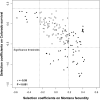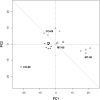Strong selection genome-wide enhances fitness trade-offs across environments and episodes of selection
- PMID: 24102539
- PMCID: PMC3928097
- DOI: 10.1111/evo.12259
Strong selection genome-wide enhances fitness trade-offs across environments and episodes of selection
Abstract
Fitness trade-offs across episodes of selection and environments influence life-history evolution and adaptive population divergence. Documenting these trade-offs remains challenging as selection can vary in magnitude and direction through time and space. Here, we evaluate fitness trade-offs at the levels of the whole organism and the quantitative trait locus (QTL) in a multiyear field study of Boechera stricta (Brassicaceae), a genetically tractable mustard native to the Rocky Mountains. Reciprocal local adaptation was pronounced for viability, but not for reproductive components of fitness. Instead, local genomes had a fecundity advantage only in the high latitude garden. By estimating realized selection coefficients from individual-level data on viability and reproductive success and permuting the data to infer significance, we examined the genetic basis of fitness trade-offs. This analytical approach (Conditional Neutrality-Antagonistic Pleiotropy, CNAP) identified genetic trade-offs at a flowering phenology QTL (costs of adaptation) and revealed genetic trade-offs across fitness components (costs of reproduction). These patterns would not have emerged from traditional ANOVA-based QTL mapping. Our analytical framework can be applied to other systems to investigate fitness trade-offs. This task is becoming increasingly important as climate change may alter fitness landscapes, potentially disrupting fitness trade-offs that took many generations to evolve.
Keywords: Antagonistic pleiotropy; conditional neutrality; ecological genetics; evolutionary constraints; fitness components; local adaptation.
© 2013 The Author(s). Evolution © 2013 The Society for the Study of Evolution.
Figures







References
-
- Anderson JT, Geber MA. Demographic Source-Sink Dynamics Restrict Local Adaptation in Elliott's Blueberry (Vaccinium Elliottii) Evolution. 2010;64:370–384. - PubMed
-
- Bennington C, Fetcher N, Vavrek M, Shaver G, Cummings K, McGraw J. Home site advantage in two long-lived arctic plant species: results from two 30-year reciprocal transplant studies. Journal of Ecology. 2012;100:841–851.
-
- Brunelle A, Whitlock C, Bartlein P, Kipfmueller K. Holocene fire and vegetation along environmental gradients in the Northern Rocky Mountains. Quaternary Science Reviews. 2005;24:2281–2300.
MeSH terms
Grants and funding
LinkOut - more resources
Full Text Sources
Other Literature Sources
